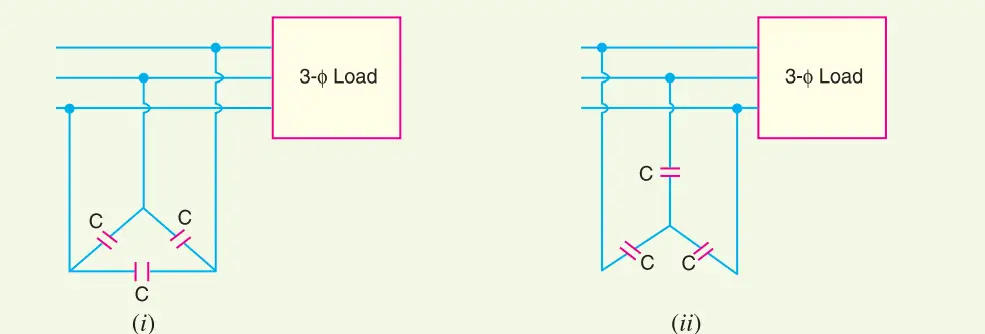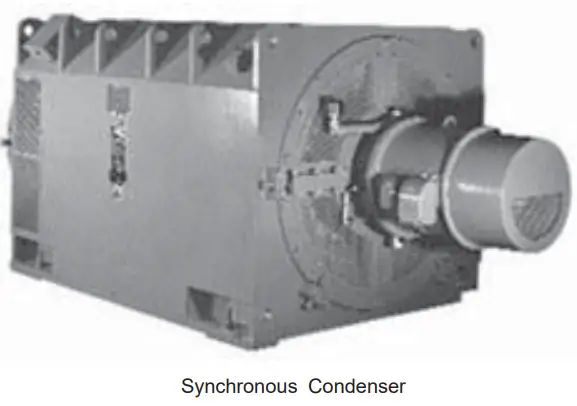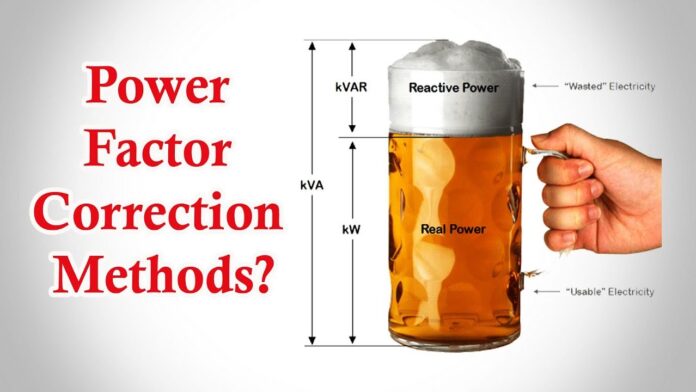The low power factor is mainly due to the fact that most of the power loads are inductive and, therefore, take lagging currents. In order to improve the power factor, some devices taking leading power should be connected in parallel with the load.
Normally, the power factor of the whole load on a large generating station is in the region of 0·8 to 0·9. However, sometimes it is lower and, in such cases, it is generally desirable to take special steps to improve the power factor. This can be achieved by the following equipment:
- Static capacitors 2. Synchronous condenser 3. Phase advancers
1. Static capacitor
 The power factor can be improved by connecting capacitors in parallel with the equipment operating at a lagging power factor. The capacitor (generally known as a static capacitor) draws a leading current and partly or completely neutralizes the lagging reactive component of the load current. This raises the power factor of the load. For three-phase loads, the capacitors can be connected in delta or star as shown in Fig. above Static capacitors are invariably used for power factor improvement in factories.
The power factor can be improved by connecting capacitors in parallel with the equipment operating at a lagging power factor. The capacitor (generally known as a static capacitor) draws a leading current and partly or completely neutralizes the lagging reactive component of the load current. This raises the power factor of the load. For three-phase loads, the capacitors can be connected in delta or star as shown in Fig. above Static capacitors are invariably used for power factor improvement in factories.
Advantages
- (i) They have low losses.
- (ii) They require little maintenance as there are no rotating parts.
- (iii) They can be easily installed as they are light and require no foundation.
- (iv) They can work under ordinary atmospheric conditions.
Disadvantages
- (i) They have short service life ranging from 8 to 10 years.
- (ii) They are easily damaged if the voltage exceeds the rated value.
- (iii) Once the capacitors are damaged, their repair is uneconomical.
2. Synchronous condenser

A synchronous motor takes a leading current when over-excited and, therefore, behaves as a capacitor. An over-excited synchronous motor running on no load is known as a synchronous condenser. When such a machine is connected in parallel with the supply, it takes a leading current which partly neutralizes the lagging reactive component of the load. Thus the power factor is improved.
Advantages
- (i) By varying the field excitation, the magnitude of current drawn by the motor can be changed by any amount. This helps in achieving step-less control of the power factor.
- (ii) The motor windings have high thermal stability to short circuit currents.
- (iii) The faults can be removed easily.
Disadvantages
- (i) There are considerable losses in the motor.
- (ii) The maintenance cost is high.
- (iii) It produces noise.
- (iv) Except in sizes above 500 kVA, the cost is greater than that of static capacitors of the same rating.
- (v) As a synchronous motor has no self-starting torque, therefore, auxiliary equipment has to be provided for this purpose.
Note: The reactive power taken by a synchronous motor depends upon two factors, the d.c. field excitation and the mechanical load delivered by the motor. Maximum leading power is taken by a synchronous motor with maximum excitation and zero loads.
3. Phase advancers
Phase advancers are used to improve the power factor of induction motors. The low power factor of an induction motor is due to the fact that its stator winding draws an exciting current which lags behind the supply voltage by 90°. If the exciting ampere turns can be provided from some other a.c. source, then the stator winding will be relieved of exciting current and the power factor of the motor can be improved.
This job is accomplished by the phase advancer which is simply an a.c. exciter. The phase advancer is mounted on the same shaft as the main motor and is connected to the rotor circuit of the motor. It provides exciting ampere turns to the rotor circuit at slip frequency. By providing more ampere-turns than required, the induction motor can be made to operate on a leading power factor like an over-excited synchronous motor.
Phase advancers have two principal advantages.
- Firstly, as the exciting ampere-turns are supplied at slip frequency, therefore, lagging kVAR drawn by the motor is considerably reduced.
- Secondly, phase advancer can be conveniently used where the use of synchronous motors is inadmissible.
However, the major disadvantage of phase advancers is: They are not economical for motors below 200 H.P.
Importance of Power Factor Improvement
The improvement of the power factor is very important for both consumers and generating stations as discussed below:
1. For consumers: – A consumer has to pay electricity charges for his maximum demand in kVA plus the units consumed. If the consumer improves the power factor, then there is a reduction in his maximum kVA demand and consequently, there will be annual savings due to maximum demand charges.
Although power factor improvement involves extra annual expenditure on account of p.f. correction equipment, yet improvement of p.f. to a proper value results in the net annual saving for the consumer.
2. For generating stations: – A generating station is as much concerned with power factor improvement as the consumer. The generators in a power station are rated in kVA but the useful output depends upon kW output. As station output is kW = kVA × cos φ, therefore, the number of units supplied by it depends upon the power factor.
The greater the power factor of the generating station, the higher the kWh it delivers to the system. This leads to the conclusion that an improved power factor increases the earning capacity of the power station.









